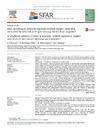Identificador persistente para citar o vincular este elemento:
https://accedacris.ulpgc.es/jspui/handle/10553/74496
| Título: | Does sevoflurane preserve regional cerebral oxygen saturation measured by near-infrared spectroscopy better than propofol? | Autores/as: | Valencia, Lucia Rodríguez Pérez, Aurelio Eduardo Kulmorgen, B. Santana, R. Y. |
Clasificación UNESCO: | 321303 Anestesiología | Palabras clave: | Sevoflurane Propofol Cerebral oximetry Cerebral oxygenation Monitoring |
Fecha de publicación: | 2014 | Publicación seriada: | Annales Francaises d'Anesthesie et de Reanimation | Resumen: | OBJECTIVE: The aim of this study was to compare the effect of sevoflurane and propofol on cerebral oxygenation, using regional cerebral oxygen saturation (SrO2) measured by near‐infrared spectroscopy (NIRS). STUDY DESIGN: Prospective, randomized, controlled study. PATIENTS AND METHODS: Fifty‐four patients aged between 18 and 65 years who underwent elective minor surgery (tumorectomy for breast cancer or inguinal hernia repair) were randomly assigned to receive sevoflurane or propofol anaesthesia. Exclusion criteria included pre‐existing cerebrovascular diseases, anaemia, ASA >III, blood loss >200 mL, arterial hypotension, baseline pulse oximetry <97%, sign of sensor low quality of SrO2 or bispectral index, and patients with a forehead area <6.5cm. SrO2, bispectral index, haemodynamic data and anaesthetic doses were recorded during surgery. RESULTS: A total of 48 patients were included in the final analysis (24 in each group). There were no significant differences in mean, minimum and maximum SrO2 between sevoflurane and propofol groups. The relative maximum decrease was higher in propofol anaesthesia than sevoflurane anaesthesia (9.6+/‐10.7 versus 4.2+/‐7.2%; P=0.048). Cerebral desaturation (20% reduction from SrO2 baseline during 15 seconds) occurred in 4 patients in propofol group exclusively (P=0.109). SrO2 adjusted for baseline was higher in the sevoflurane group than in the propofol group (67.3+/‐1.8% versus 64.2+/‐1.7%; P=0.018). There were no significant differences in haemodynamic parameters between the two groups. CONCLUSIONS: Cerebral cortical oxygenation measured by NIRS may be better preserved with sevoflurane than with propofol. These findings suggest that sevoflurane anaesthesia could be a good option in patients with compromised cerebral oxygenation, given the absence of intracranial hypertension. Further studies with larger sample sizes are required to support our results. | URI: | https://accedacris.ulpgc.es/handle/10553/74496 | ISSN: | 0750-7658 | DOI: | 10.1016/j.annfar.2013.12.020 | Fuente: | Annales francaises d'anesthesie et de reanimation [ISSN 0750-7658], v. 33(4), p. 59‐65 |
| Colección: | Artículos |
Visitas 10
214
actualizado el 25-oct-2025
Descargas
406
actualizado el 25-oct-2025
Google ScholarTM
Verifica
Altmetric
Comparte
Exporta metadatos
Los elementos en ULPGC accedaCRIS están protegidos por derechos de autor con todos los derechos reservados, a menos que se indique lo contrario.
